What is wine? How did it get its name? And why is it so important to our culture?

Wine has been around since ancient times. In fact, it was one of the first fermented beverages ever discovered. Today, it remains one of the most widely consumed alcoholic beverages in the world.
Wine has a rich history – it’s pretty fascinating! Here’s everything that you need to know about the history of wine, so you can impress your friends and family during your next wine night!
Tracing Its Roots
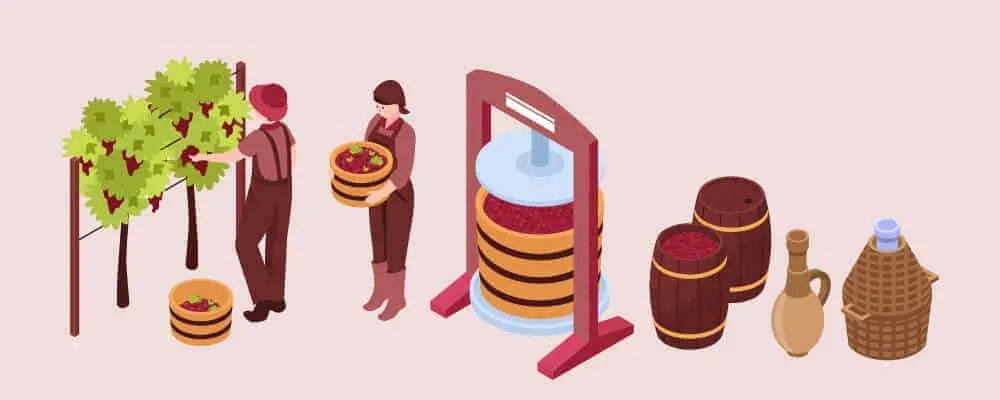
Where Did Winemaking Actually Begin?
As with most things in history, there is a bit of debate about where winemaking began since it was so long ago that it started. There’s even evidence of winemaking discovered in an 8000 year old village!
In truth, nobody can really be 100% sure about where wine was first created, though there are Persian fables that state that a woman – a princess – first discovered the delicious beverage. It was quite a tragic story in which the woman in question tried to consume grapes in order to commit suicide, but it’s not likely that this is what happened in reality.
In terms of physical evidence, we know that there are 60 million year old fossils that have been discovered. These were found in the Northern Zagros Mountains in Iran, and they were from around 5400-5000 BC.
In general though, we believe that it’s likely that wine making began some time after 6000 BC. According to archaeological information that we now have, it is believed that the very first wine was made in China in roughly 7000 BC.
Asia
We know from archaeological research that the first chemically confirmed beverage with alcohol in it was discovered in China. Specifically, it was found at Jiahu. The evidence came in the form of Clay jars that were used for storing fermented drinks.
These drinks were made out of all sorts of ingredients – not very similar to the wines that we see today! Such ingredients were rice, hawthorn fruit, honey, and of course – wild grapes.
From what we know, it appears likely that the wines that were made at this time would be consumed for religious purposes, such as ceremonies and burials.
Researchers have also found what is believed to be the oldest winery on the planet in Armenia. The winery was found in a cave in the mountains, and it contained a lot of wine related items including fermentation jaws, drinking apparatus and a grape press.
The wine created in these caves was believed to be from the same grapes that we use in wine at present. Researchers believe that again, this wine was most probably used for religious purposes, particularly for burials.
Later from the 1980s, China would become one of the biggest makers in wine for quite some time thanks to the economic boom at the time. Rice wine and grape wine were both popular there. Lately China doesn’t produce as much wine as it once did, but it’s still a pretty large provider of wine worldwide.
Europe
The wine trade would be started by the Phoenicians around 1200 BC – 539 BC, and this is when wine made its way to Europe.
Initially, the Greeks started drinking wine as a religious symbol – they even chose to name a god after the delicious beverage. They would fill baskets with the grapes that they harvested and then they would be crushed and put into earthenware jars.
The fermentation process would take place in these jars. They would also transport the grape vines to new areas like Sicily and Rome.
The drink was also immensely popular in Rome, where again, the Romans would name a god after the beverage – Bacchus. What’s interesting about wine in Rome though is that it was pretty easy to access regardless of your economic status – both the rich and the poor could enjoy wine, since wine was such a massive part of the day to day lives of the ancient Romans.
Of course, as you may expect, the poorer members of the population would often have wine of a poorer quality. This wine would often be made of mustum, vinegar, lora, and mulsum.
Eventually, grapevines would start cropping up throughout Europe thanks to the Romans, including in France, Spain, Italy, Germany and Portugal.
The practice of drinking wine eventually made its way into the Catholic Church, symbolizing the sacrament of the Eucharist. Even today, wine is often drunk to commemorate the blood of Christ during the last supper.
It was later in the 1400s with Christopher Columbus’ discovery of America though that wine would truly take off worldwide. It made its way to Spain and new types of wine were made, particularly from the Mission grape.
Later on, around 1662, everyone’s favorite wine based beverage was researched by Christopher Merrett – champagne. It wasn’t until around 30 years later that Don Perignon would make his own champagne.
Much like today, champagne was often a beverage that was only drunk on special occasions. It was often difficult to have champagne on a regular basis since the bottles would often explode thanks to the pressure on them, so most of the champagne would be lost. Don Perignon would eventually create tougher bottles for champagne, so this would not remain an issue for long.
Americas
Wine is pretty popular in the United States – as many of us may already know! With that in mind though, wine isn’t the most popular beverage here in the states – that would go to beer!
Initially, wine was consumed in South America by Spanish people for religious purposes. It later arrived in North America when the colonists fled to the new world.
At present, California is the place that produces the most wine in America. For the most part, most of the wine that’s drunk in America is made in America, rather than imported from other countries.
A big discovery was made in America though about the barrels. For the most part, Americans were creating whiskey barrels more than anything else, and so the wood would be kiln dried rather than air dried for 2 years before use.
It was also discovered that American oaks were not necessarily the best way to go when it came to making wine barrels, since the flavor of the oak could be imparted onto the wine too much. This would often change the flavor quite dramatically.
Africa
In Ancient Egypt, wine was also quite prominent. Wine was made from red grapes in ancient Egypt around 3100 BC. What’s particularly interesting about this is the fact that in present day Egypt, wine making isn’t nearly as big as it used to be.
If you visit some of the tombs in Egypt, you will actually see markings etched into the walls showing how the wine making and drinking process would go. Wine would often be put into amphoras, which are jars made out of clay and would be jars with handles and a very narrow neck. The wine would ferment inside of these jars.
Unsurprisingly, red wine was often used in different ceremonies in ancient Egypt. As is the case with many other ancient civilizations, it would be used for burials and sometimes would even be used as a form of medicine. Many Egyptians were superstitious about it since the color resembled blood.
Processes Of Creating Wine
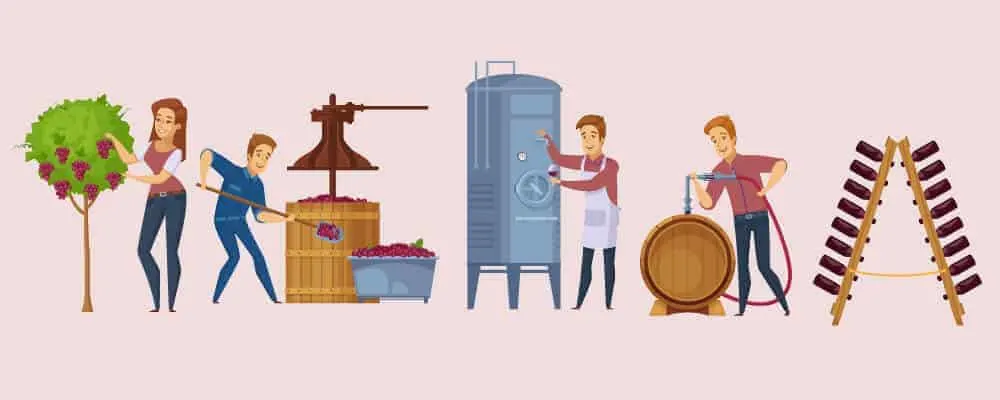
So how is wine made – what’s the process? There are many different ways to make wine, but typically winemakers will follow the steps listed below.
Harvesting
The process of making wine begins with grapes being harvested from vineyards. If you don’t have the grapes then in most cases you will be unable to make the wine. There aren’t any other fruits that you can use that will give the right taste, or the right acids, tannins and esters to create wine.
The wine harvesting process begins at the vineyard when the grapes are ripe. The grapes need to be harvested at a specific time though. Determining when to harvest can sometimes be a little tricky, but usually you need to taste test the grapes beforehand.
When the grapes are ready for harvest they are placed into large bins which are later shipped to the winery. They can be harvested either by hand or can be harvested by mechanical machines. In most cases wine makers will prefer to harvest them by hand though. Any fruits that are rotten will be discarded later on when the grapes get to the winery.
Crushing
Crushing wine grapes is an essential step in creating wine. It helps release the juice out of the grape skins which allows the alcohol to come out. This is what gives wine its characteristic flavor. Crushing also breaks down the cell walls of the grape skin allowing more oxygen to enter the grape. This makes the wine darker and richer in color.
Crushing is the next step for wine makers after the initial batch of grapes is harvested.
These days, we have all sorts of machines that can help with the process of crushing wine. Mechanical crushers are generally used in order to press and crush the grapes. In the past, people would stomp and tread the grapes into the ground to turn them into something known as a must, but that is not necessary today.
During the must process, men and women would do harvest dancers as part of the wine making ritual. Unfortunately this does not tend to happen today except in the Grape Harvest Festival! This festival started in 1936, so it’s been around for quite some time.
Pressing
If the winemaker is making white wine though, it’s worth noting that they will need to press the must quickly after the grapes have been crushed. This helps to ensure that the juices and skins are separated from one another. It helps to stop any unwanted color from getting into the resulting wine.
After the grapes have been crushed into a must, they go through a process known as pressing. Pressing involves using a machine to squeeze the grape juice out of the skins. These machines can be manual or automatic.
Manual presses require someone to manually push the grapes against a series of rollers. Automatic presses work much like a juicer. A motorized arm pushes the grapes against a series rollers.
When pressing wine, it’s always important to consider how hard you’re pressing. If the must is pressed two hard then the tannins can come out, and these can be rather harsh. If you press too soft though, the color of the wine can be much lighter than intended and it can have an impact on the overall texture.
Fermentation
Once the grapes are crushed and pressed, they are transferred to fermenters which are tanks that contain yeast. This is what causes fermentation to take place. Fermentation takes place over several weeks, though in some cases it can even take more than a month.
During this period the sugars in the grape juice convert into alcohol and carbon dioxide. At the end of this process the winemaker has a sweet smelling liquid that contains ethanol (alcohol).
The wine maker then transfers the fermented wine into oak barrels. Oak barrels are containers made of wood that allow the wine to breathe while it ages. They also add a nice aroma and flavor to the finished product.
In most cases, wine will have an alcohol level of 10% if it is made in a cooler (see also: Best Built-In Wine Coolers – Our Reviews and Buying Guide)climate, but a level of 15% in areas that are warmer.
Clarification
Now that the fermentation process is complete, the clarification process needs to occur. Wine clarification is when the wine maker removes the sediment and any other debris that has settled at the bottom of the barrel during the aging process. It helps to stop the wine from looking dull and cloudy.
In most cases, there is a natural clarification process that occurs after fermentation, and this means that the grape particles stick to the bottom of the barrel. Wine is usually racked or siphoned then, being put into a new container so that the lees are left behind in the old container.
In most cases, racking is the ideal thing to do to clarify wine because it removes the yeast particles that are left over. This is important, as the wine can taste different if the yeast is not removed. In particular, racking is the most effective clarification method for red wine, thanks to the tannins in red wine.
There are actually a couple of clarification methods for wine.
The first method is fining. Fining is where the wine maker adds chemicals such as egg whites or bentonite clay to help remove the particles that settle at the bottom of the wine.
Another option is filtration. Filtering is where the wine maker uses filters to separate the wine from the yeast. There are many types of filters available, including nylon mesh filters, paper filters, and stainless steel filters.
Floatation is another option. Floatation is where the wine maker puts the wine into a tank with air bubbles. These bubbles cause the particles to rise to the top of the tank.
Aging and Bottling
Last but not least, the wine needs to go through the aging process and must be bottled. You can either choose to bottle the wine right after clarification, or you can allow it to age further, giving the wine a richer taste. What you choose to do depends on personal preference.
After that, it’s either distributed and consumed – or stored in a quality wine cooler for later consumption.
Global Wine Producers
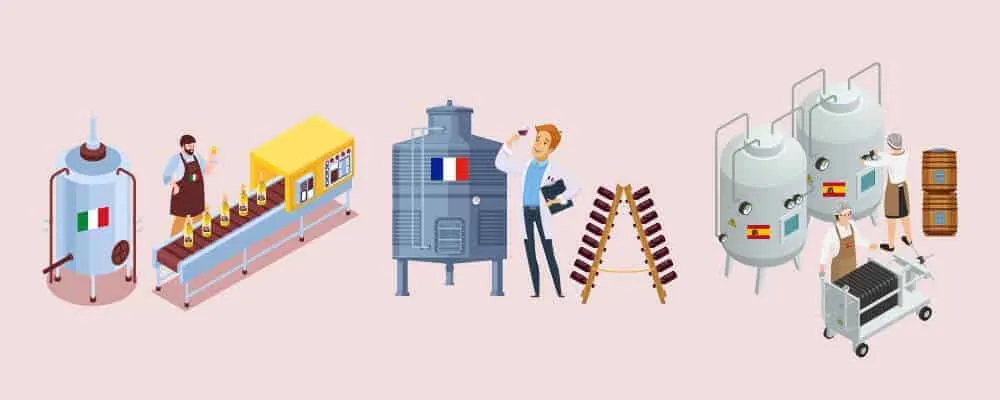
So where is wine most commonly made throughout the globe? These days, it’s particularly popular in European countries, but there are wine producers throughout the world. Here are a few things that you should know about them.
France
France is very well known for its wine production. There are wineries all throughout the country. Millions of tourists every year visit France just to see the wineries and get a taste of French wine. The country has been creating wine since the 6th Century, BC.
In France, pretty much all of the main kinds of wine are made, including rose, white wine, fortified wine and red wine. There are also wines that are unique to France, known as French fortified wines.
There are a few grape varieties that are common in France that go into some of the most popular wines in the world. In Bordeaux you have Cabernet Sauvignon, (see also: Caymus Cabernet Sauvignon)and in Rhone there’s Syrah.
There are also French wines that are made out of a few different kinds of grapes. These are known as varietal wines, and they’re typically white rather than red wines.
Spain
Spanish wine has been around quite some time, dating back to the ancient civilizations. La Mancha is the region of Spain that currently produces the most wine, shortly followed by Catalonia.
There are many different types of grapes in Spain, but there are only 20 grape varieties that are generally used in the region. Airen is the main kind of grape used for white wine, while Tempranillo is the type most often planted for red wine.
Sherry is a kind of wine that is often made in Spain, alongside Cava.
Italy
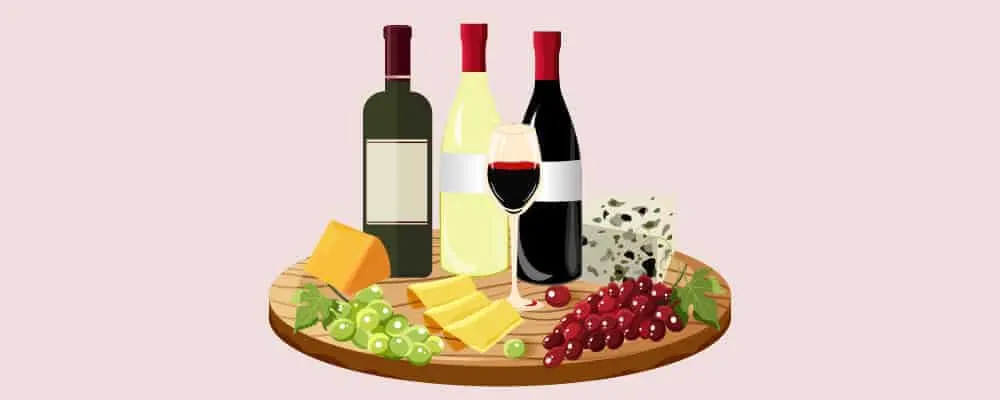
When you think of Italy, one of the first things that you may think of is Italian wine. Italy produces more wine than any other country in the world, and a very large portion of the landmass is made up of vineyards – around 1,730,000 acres to be precise.
There are numerous varieties of grapes used in Italian wine, including Arneis, Moscato blanc, Fiano and vermentino. There are also grapes grown specifically for red wine, like barbera, aglianico and sangiovese.
Italy is also known for its wine guides, (see also: Pineapple Wine Recipe & Guide)such as the Gambero Rosso and Slow Wine. These are publications produced in Italy that are designed to advise consumers on the hottest wines.
Italy is known for a number of very popular wines, including Sauvignon, Pinot Grigio, Vermentino and Lison.
South Africa
A lot of delicious wine is created in South Africa. There are many different varieties, made from many different kinds of grapes.
There are two kinds of South African grapes that are particularly well known – chenin blanc and red pinotage. They’re dry grapes that provide a lot of flavor. It’s worth noting though that the better wines from South Africa typically tend to be blends.
Some of the most popular wines in South Africa include cabernet sauvignon, shiraz and merlot. South Africa is particularly well known for its fortified wine production. They refer to the wines as ‘cape port’, and they typically have a minimum alcohol level of around 16.5 – 22%.
Australia
There’s a pretty big market for wine in Australia. In fact, it’s one of the biggest wine exporters in the world.
All states in Australia product wine, though the Southern states are the main wine making regions. Most of the vineyards are located in places like Victoria, New South Wales, South Australia and Queensland.
Wines that are particularly popular in Australia include merlot, chardonnay, pinot noir, riesling and shiraz. The most well known wine from Australia is called Penfolds Grange. There are more than 2000 wine producers in Australia.
China
You may not be surprised to know that wine is a pretty big deal in China, especially because of its rich history with the beverage. China actually has more than 850,000 hectares of land dedicated to wine vineyards, a number that’s only beaten by France.
Red wine is particularly popular in China, since the color symbolizes prosperity and luck. Cabernet sauvignon is the grape variety that’s grown most often in China. China is also well known for its rice wine.
Types Of Wines
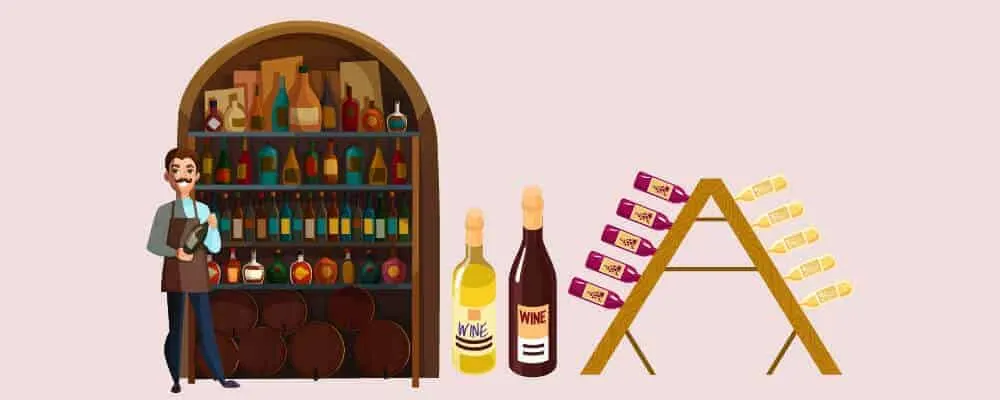
Wine is very versatile, and it can be used to accompany food in a variety of ways. There are a lot of different types of wines out there though. Here are just a few!
Dessert
Dessert wine is a type of wine that is meant to be enjoyed with desserts, as the name suggests! It tends to be sweeter than regular wine, and it tends to have a higher alcohol content than most other kinds of wines.
It is often served chilled, and some dessert wines even contain fruit flavors.
Some dessert wines include port, madeira, sherry, sauternes and riesling. Wines like port will usually go best with things like chocolate cake, salted caramel desserts or stone fruit. It also goes well with lemon meringue pie! Madeira on the other hand goes very well with desserts like toffee pudding or chocolate truffles.
Fortified
Fortified wine is a type of fortified wine that contains added distilled alcohol. This means that the alcohol content in the beverage is higher as a result.
Of course, you can’t just add any old distilled spirit to a glass of wine and call it fortified. There are typically regulations involved with making fortified wine, which is what makes them so special. There will be guidelines on the base wine type you can use, alcohol content, aging minimums, what spirit you can use and more.
There are actually a few different types of fortified wines out there, including:
Port – A sweet fortified wine that comes from Portugal. Port is typically aged for a long time before bottling. It’s great with cheese platters and seafood dishes.
Madeira – Also known as “sweet wine”, madeira is a fortified wine that comes from the island of Madeira. It has a distinctive flavor profile due to its unique volcanic soil. It pairs well with nuts, dried fruits and cheeses.
Marsala – Marsala is a fortified wine that is produced in Sicily. It is light bodied and has a rich aroma. It pairs well with pasta, fish and chicken dishes.
Red
Red wine is one of the most popular types of wine around. It is available in many varieties, ranging from dry to sweet.
The color of red wine is determined by the amount of tannins present. Tannins give red wine its characteristic bitter-tasting flavor. They come from grape skins and seeds, and they tend to make red wine taste older and more complex.
The color of red wine is also affected by the level of anthocyanin (a pigment found in grapes) present. Anthocyanin gives red wine its deep red hue. This is why red wine tends to look darker when compared to white wine.
When serving red wine, try to serve it at room temperature. If you don’t want your guests to feel warm while drinking their wine, then keep an open bottle of ice water nearby. You can also chill the bottle if you prefer.
If you’re serving red wine with food, try to pair it with something hearty. For example, if you were having beef stew, then you could serve your guests beef stew along with a nice glass of red wine.
You can find red wine in several varieties, such as:
Pinot Noir – Pinot noir is a variety of red wine that comes from France. It is considered to have a fruity, floral aroma. It pairs well hot or cold, but it is especially good served chilled.
Merlot – Merlot is another French varietal. It has a smooth texture and a medium body. It pairs well with spicy foods, poultry and vegetables.
Cabernet Sauvignon – Cabernet sauvignon is a variety of red wine that originated in Bordeaux, France. It has a strong, full-bodied flavor and a dark garnet color. It pairs well with meats, games, and desserts.
White
White wine is another popular type of wine. It is often served cool, and it doesn’t contain as much tannic acid as red wine does – nor does it need to be aerated. White wine is usually lighter than red wine, and it is lower in alcohol.
The main difference between white wine and red wine is that white wine contains less tannic acid and higher levels of sugar. As a result, white wine is typically sweeter than red wine.
There are two major categories of white wines:
Champagne – Champagne is a sparkling wine (see also: Champagne vs Sparkling Wine)that originates from the region of Champagne in northern France. It is best enjoyed on special occasions like birthdays and anniversaries.
Sauvignon Blanc – Sauvignon blanc is a versatile white wine that comes from the region of Sancerre in western France. It’s milder and fruitier than other whites. It pairs well with seafood, salads and Asian cuisine.
White wine should be served chilled – with the help of an ice bucket or a single bottle wine chiller.
Rose
Rose wine is made from the same ingredients used for making regular wine. The difference is that it doesn’t ferment with the grape skins for as long of a duration as other kinds of wines. You can make it with pretty much any kind of red grape, and it’s particularly popular in France.
Rose wine has a fruity and fresh taste and it works really well with a lot of different foods. It works particularly well with things like barbecued meats, spicy foods and roasts.
Sparkling
Sparkling wine is made using carbon dioxide which is what makes it fizzy!
It is typically served chilled, although you can serve it at room temperature too. When you’re buying sparkling wine, look for bottles that are labeled “sparkling” or “fizz”. An example of a sparkling wine is prosecco.
Rice
Rice wine is typically made out of fermented flutinous rice. There are sugars inside of it, and this then becomes alcoholic thanks to yeast. It’s a beverage that’s often consumed in Asian cuisine. It’s pretty sweet in terms of flavor, making it a good additive for lots of recipes like shumai dumplings.
Conclusion

Wine has a pretty rich history, but it’s surprising how little many of us actually know about it! Hopefully now you have learned a few things about the history of wine!
